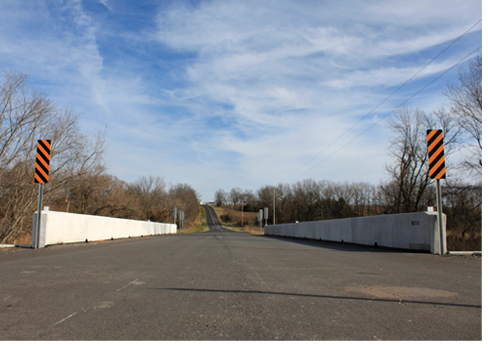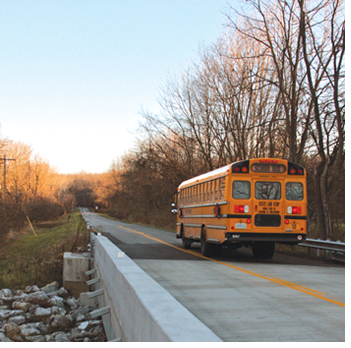Safe and sound
 It happens all day, every day. Thousands of Boone County motorists and pedestrians cross bridges and other infrastructures without giving a second thought to their safety.
It happens all day, every day. Thousands of Boone County motorists and pedestrians cross bridges and other infrastructures without giving a second thought to their safety.
But across the United States, dozens of bridges, mostly smaller structures, fail every year. In 2007, the catastrophic collapse of the Interstate 35 Mississippi River Bridge in Minneapolis made headlines nationwide. Since then, the failure of that bridge has been attributed to faulty design from gusset plates used to connect steel girders. Plates were designed too thin for the load and broke, causing mass death and destruction.
Missouri State Bridge Engineer Dennis Heckman says area engineers took the lead in examining gusset plates in state, and those used here have been designed correctly and determined as safe for use. The Minnesota disaster, however, did serve as a wake-up call for bridge engineers everywhere.
In the past, Missouri received negative recognition as one of the nation’s top 10 states with the most deficient bridges; but since the implementation of the Missouri Department of Transportation’s (MODOT) Safe & Sound Bridge Improvement Program, the state has been dropped from the list. So far, 672 Missouri bridges have been repaired through the program, 12 of which are in Boone County, with the ultimate goal of 802 statewide.
Data from the Federal Highway Administration National Bridge Inventory shows that 27 percent of Missouri’s bridges are “structurally deficient” or “functionally obsolete.” That may sound scary, but it helps to understand what engineers mean when they use those phrases. Bridges are unique in the way they age, but those classifications don’t necessarily equate to unsafe structures, say highway officials.
As most bridges are designed with a 50-year lifespan, many are approaching that benchmark. But bridge engineers have programs in place to inspect and monitor bridges as they age and budget years ahead for repairs and replacements. All bridges meeting the federal definition of 20 feet or longer must be inspected every two years by the state.
Bridges are considered “structurally deficient” if load-carrying structures are found to be in poor condition due to deterioration, or if the bridge has been affected to the point of causing traffic problems or interference with the bridge’s purpose. The structure may need significant maintenance and/or repair to remain in service and sometimes require posting for weight limits; but engineers keep a cautious watch on those that are showing signs of wear. While most people tend to think of bridges in terms of everyday auto traffic, many are built for other reasons such transporting pipes, railroad tracks or other elements needing across a certain obstacle, such as a river.
Bridge sufficiency ratings are calculated by a formula taking into account structural condition, traffic volumes, number of lanes, importance of use, and other factors. Sufficiency ratings are used to determine eligibility for federal bridge replacement funding. “Every bridge that is open to the public is safe,” says Heckman. “If I won’t drive my family on it, I close it.”
“Functionally obsolete” describes a bridge that was built to standards that are no longer in use today. These bridges may not be structurally deficient but were designed for earlier traffic flows and are in need of upgrading. Think of an older house that doesn’t meet current codes but is still livable.
 According to highway officials, there are 143 state-maintained bridges in Boone County; 17 of which are considered “structurally deficient” and 20 “functionally obsolete.” The average age of the state bridges is 41.8 years. Heckman estimates the total number of non-state maintained bridges in Boone at 199, with 10 as “structurally deficient” and 11 “functionally obsolete.” The average age of those bridges is 32.4 years.
According to highway officials, there are 143 state-maintained bridges in Boone County; 17 of which are considered “structurally deficient” and 20 “functionally obsolete.” The average age of the state bridges is 41.8 years. Heckman estimates the total number of non-state maintained bridges in Boone at 199, with 10 as “structurally deficient” and 11 “functionally obsolete.” The average age of those bridges is 32.4 years.
“Flooding and scour are the biggest enemies we have,” Heckman says. Churning water undermines bridge piers similarly to the way receding ocean waters pull sand from underneath a person’s feet. Abutments in water are especially susceptible to corrosion where the structure leaves the water. The water-air combination tends to hasten deterioration. Pre-stressed concrete is subject to fracture as it ages. Wooden decks, which are designed to be replaced, tend to rot; and steel fatigues with age.
Technology has improved inspections, particularly those made underwater, with the use of bathymetric surveys. Side scan sonar has replaced the need for divers to go underwater and provides engineers with 3-D color pictures of erosion and debris.
Derin Campbell, a civil engineer in charge of the Engineering Division of Boone County Resource Management, says the county maintains 160 structures meeting the federal definition of a bridge, and that “somewhere between 2,000 and 5,000” are less than 20 feet. Many occur on private roads. Some that merit close watch are those concrete structures built between 1900 to 1920, not designed for today’s heavier traffic.
Campbell says the county received about $100,000 in federal money for bridge replacement, which is a relatively low figure compared with other regions. The funding, he says, is distributed based on a formula based on square footage of deficient bridge decking. The more deficiencies detected, the more money an area is likely to receive. “We’re getting less because we’re in relatively good shape,” he says.
Campbell says Boone has a dedicated pavement preservation program for asphalt and concrete roads. Asphalt roads have a shorter life and are easier to maintain, but the price of oil affects their cost. Concrete roads last longer, but are more expensive to build at the outset. The county now has an asphalt rehabilitation program in place, but with limited funding, the county is currently working to maintain what is has, he says. Projects planned for 2012 include construction on High Point Bridge, Rolling Hills Road, St. Charles/Lake of the Woods roundabout and Sunrise Estate Phase IV. Design work will be done on Creasy Springs Bridge and Hill Creek Bridge.
Jill Stedem, public information specialist for the City of Columbia, says there are about 20 bridges meeting the federal definition and none are currently in need of major repairs or replacement. Most are in good condition.
Heckman agrees with the local officials’ assessments. “Generally, Boone County and Columbia pay attention to their bridges,” he says. “We feel they are using their limited funds wisely.”
The Columbia Area Transportation Study Organization (CATSO) functions as the Metropolitan Planning Organization responsible for the Transportation Improvement Program (TIP), a schedule of intended transportation improvements or continuations of current activities over a four-year period by the Missouri Department of Transportation (MODOT), Boone County and the City of Columbia. According to a CATSO summary of projects for fiscal years 2011-2014, new road and bridge construction estimated at $3.6 million is planned in Boone. Most of the money is projected for 2014, with no bridge projects listed for Columbia.
Heckman says engineers don’t necessarily pick the oldest bridges for repair first. Priority is given to how much the road is used and the level of problems its closure might create. A bridge with an 80-mile detour as the only alternative would be given higher priority than one with little use and alternative routes, he says.
The Missouri Highways & Transportation Commission, an unpaid six-member body with broad representation by three Republicans and three Democrats, is in charge of distributing money to seven state districts. Boone County is at the top end of the Central District, which includes 18 Missouri counties.
To find out more, visit modot.org.


